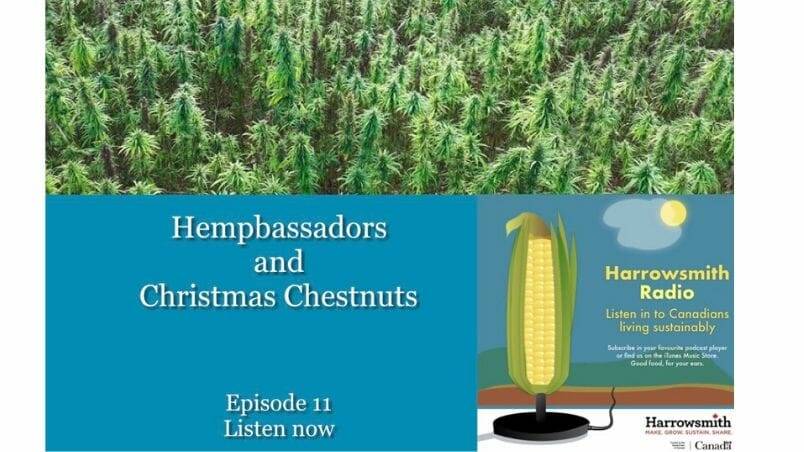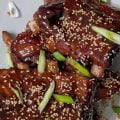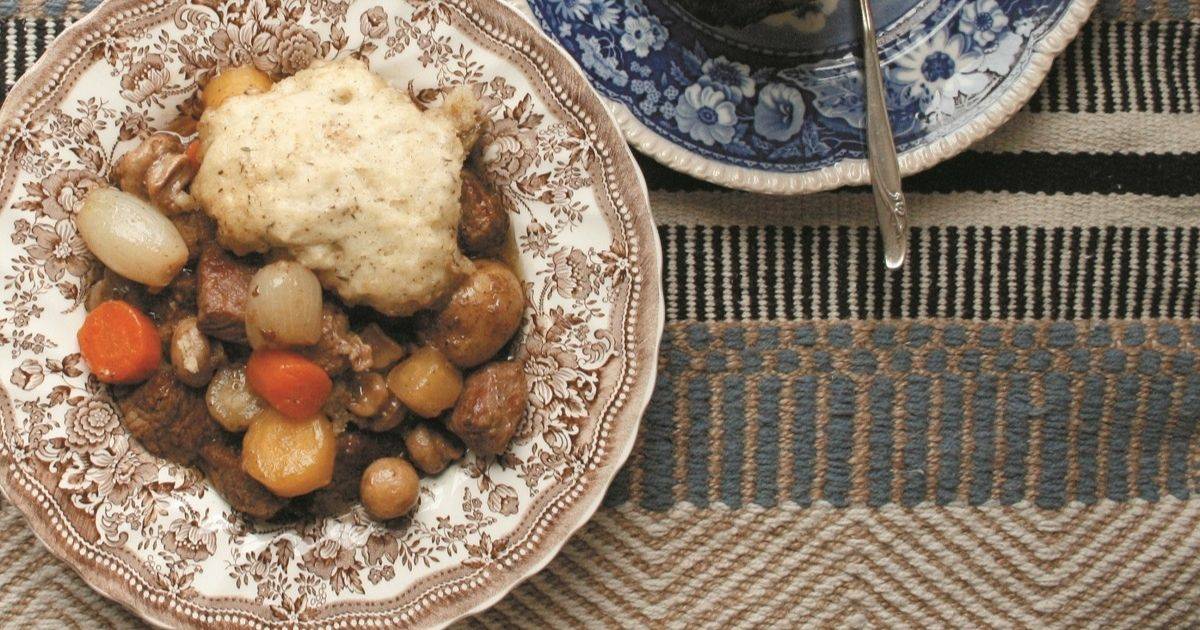Freshly roasted chestnuts. What could be so hard? Right? Crank the oven, pop ’em in, and wait for the kitchen to fill with the magic of the season.
Oh, the kitchen filled up all right. First with the muffled sound of explosions. Then with the sort of language you’d expect to find on a loading dock full of cranky stevedores.
I’m curious and tend to jump into things, so naturally I immediately opened the oven door and stuck my head in to see what all the fuss was about. My soft, non-helmeted, un-goggled head.
More pottymouth.
I don’t know why I thought the right thing to do was to withdraw the pan of frighteningly swollen nuts from the safe—albeit hot—confines of the oven, but that’s exactly what I did. They spluttered and sizzled, some rocking under their own steam, mere seconds away from launching with the destructive power of tiny scud missiles. Then just as I set the pan down, one took flight, followed closely by another and another, depositing shell shrapnel and mushy chestnut meat on the ceiling, walls, and floor.
I shoved them back into the oven, where they proceeded to rumble and pop until the gory aftermath was baked onto the enamel surface.
Confused, shocked, and a tad humiliated, I consulted Professor Google, bought more nuts, and tried again. This time it was more Christmassy, less Christmas Day massacree.
Bonus: while I was down the rabbit hole of internet chestnuts, I learned about the American chestnut’s history. It’s a little sad and all too common, but there is a ray of hope.
Up until the early 1900s, the American chestnut tree (Castanea dentata) blanketed forest floors from southern Canada down through the American Deep South with tasty and nutritious nuts enjoyed by people, livestock, and woodland creatures alike. The rot-resistant wood of this towering giant was also highly prized, but, alas, a fungal infection known as chestnut blight brought the trees to near extinction. Thankfully, growers and The American Chestnut Foundation (TACF), along with other appreciation societies in the United States and Canada, are working to bring this magnificent tree back, stronger than ever, by developing a fungus-resistant cultivar. Meanwhile, TACF suggests that it’s worthwhile to plant American chestnut trees if you have access to them—even though they will be prone to blight—in order to keep the plant alive and producing seeds while research continues. Growers in North America are working on blight-resistant Chinese-American crosses; in Europe, where the European chestnut is also under threat from blight, growers are working on a Japanese-European cross.
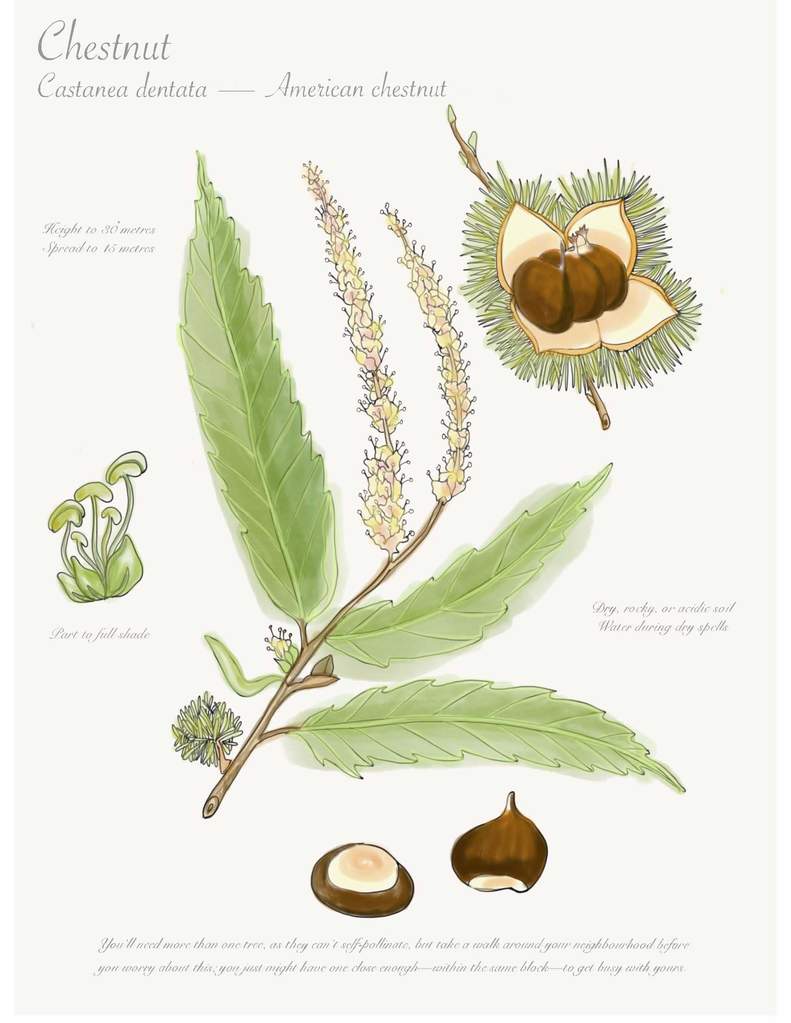
The European chestnut (Castanea sativa) is the cultivated cousin used to produce those roasted-on-an-open-fire goodies. These chestnuts are also sold boiled and peeled, candied, or ground up into a flour or paste. In France and Italy, candied chestnuts preserved in sugar syrup are called marron glacé. But don’t let the fancy European side of the family make you think that its North American kin is somehow inferior. The American chestnut is just as tasty and versatile, if much harder to find. I use either variety whenever I’m looking for a meatless meaty texture and richness.
If you want to help with the American chestnut recovery project, plant a couple trees. You may not live long enough to see it blanket your garden in nuts, but do it for the kids and grandkids, for future generations. Do it for the great American chestnut. Remember, you’ll need more than one tree, as they can’t self-pollinate. Take a walk around your neighbourhood before you splash out on the price of two, though; you just might have one close enough—within the same block—to benefit yours.
When you’re scouting, don’t confuse the American chestnut with the horse chestnut (Aesculus hippocastanum), which is native to Eastern Europe and widely planted here, especially in urban areas. Though the flowers are very pretty and smell lovely, and they do produce nuts, the nutmeat is not edible. Still, they make for a rousing game of conkers, squirrels like ’em, and in traditional Chinese medicine they’re a cure for, ahem, hemorrhoids.
To get up close and personal with American chestnuts in Southern Ontario, visit Grimo Nut Nursery in Niagara-on-the-Lake [www.grimonut.com]. To buy a bag of dried American chestnuts, visit Forbes Wild Foods [www.wildfoods.ca]. Jewels Under the Kilt sells American chestnuts that are grown on a neighbouring farm; contact them for availability [www.jewelsunderthekilt.com].

Between you and me, when time is of the essence and quantity is called for, I’m perfectly happy buying pre-roasted European chestnuts found in well-stocked grocery stores. I often eat them right out of the pouch: 2 for me, 10 for the pot. For that comforting holiday experience, however, try roasting them whole, if only once.
How to Cook Chestnuts
Boiled Chestnuts
Chestnuts must be cooked—they’re bitter and unpleasant raw—but if my story of roasting chestnuts scares you as much as pressure cooking scares me, then you can always simply boil whole chestnuts in a big pot of water over high heat for 30 to 35 minutes, until the meat inside the shell is soft and sweet. Drain and set aside until cool enough to handle. Using a paring knife, peel off the shell or simply cut each nut in half and dig out the meat.
Roasted Chestnuts
Roasted chestnuts have a natural sweetness that is delightful. Simply peel and nibble, perhaps with a sip of port. A pile of warm roasted chestnuts will take a cheese or charcuterie platter to the next level. Of course, they’re also a lovely addition to holiday stuffing. Or try them sautéed with green beans and a little (okay, a lot) of butter. A cream sauce with chestnuts, mushrooms, and marsala is absolutely decadent poured over fish, meat, poultry, or a roasted head of cauliflower. To roast chestnuts, follow my instructions below. Seriously, it won’t hurt a bit!
- Inspect each nut and give it a little shake. It should be silent, which means it’s nice and fat inside, not dried out. If there are any cracks or holes, a worm has gotten to the yummy nutmeat ahead of you. Ditch it! Likewise, toss any mouldy ones.
- Wash chestnuts in cold water, letting them soak for a bit before draining to soften the shell, which helps with the next step. If you’re roasting your chestnuts over an open flame, damp nuts char more slowly.
- Score the bottom of each chestnut: Carefully hold the nut against a board and, using a sharp paring knife, cut a deep X all the way through the shell.
- Transfer the prepared chestnuts to a large baking sheet. Roast in a hot oven (400°F/200°C) until the X you cut in each is peeling back to reveal the yummy, sweet nutmeat, about 30 minutes. You can also cook them on a hot grill (barbecue), over a campfire, or in the fireplace. For the campfire or fireplace experience, you’ll need a wire camping popcorn popper or veggie roasting basket to keep them all contained. Score as you might, they’re still liable to leap—screaming hot —into the air every now and then. Give the pan or basket a shake once in a while to ensure even roasting.
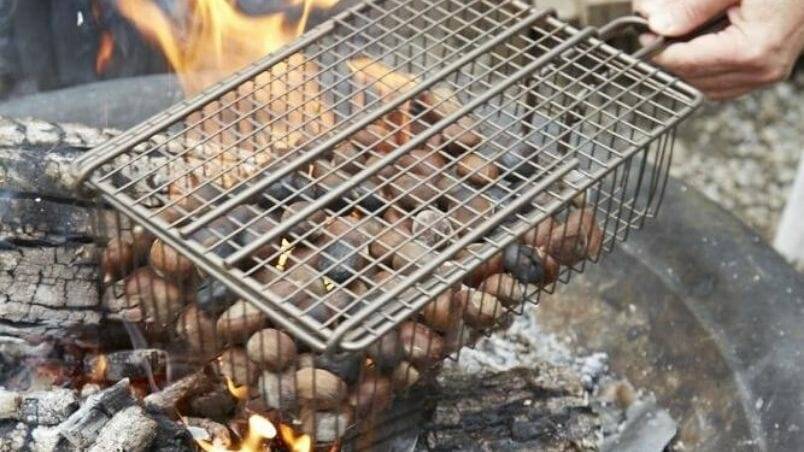
From Hudson, Quebec, now living in Port Hope, Ontario, Signe is a restaurant chef-turned-writer who tells award-winning stories and creates delicious recipes for LCBO’s Food & Drink, Manna Pro Hearty Homestead, The Harvest Commission, and Today’s Parent; she published her first book – Happy Hens & Fresh Eggs; Keeping Chickens in the Kitchen Garden with 100 Recipes – in 2015.

